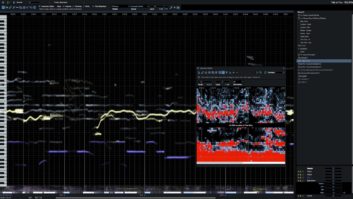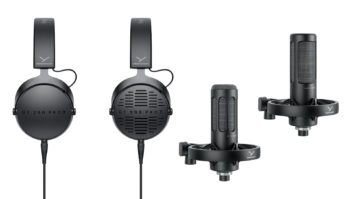
| MIX VERDICT: ANTARES AUTO-TUNE PRO X |
| THE TAKEAWAY: “The plug-in with the household name will no doubt soon have all major bugs squashed. At that point, Auto-Tune Pro X will be the speediest and most user-friendly release yet.” |
| COMPANY: Antares • https://www.antarestech.com/ PRICE: $459 (At press time, on sale for $229) PROS: • ARA2 support, • Speedier workflow. CONS: • v10.2.0 has some bugs of concern that Antares is working to rectify. |
I use pitch correction on virtually every lead vocal track I produce, but I never stop there; combining the rendered pitch-corrected track with the unprocessed vocal creates an awesome ADT (Automatic Double Tracking) effect, supersizing the money track. Now, with the release of Auto-Tune Pro X, you can create this ADT effect without leaving the plug-in’s window; simply twist the GUI’s new Mix knob to blend dry and processed sounds.
The Mix knob is just one of many new features the updated plug-in adds to speed workflow, but it’s not yet a totally smooth ride. I’m reporting here on v10.2.0, Pro X’s third iteration, as the initial release had a show-stopping bug—the AU plug-in’s all-important Graph Mode didn’t work. That’s since been fixed. Two other serious bugs remain—so serious, I feel I should discuss them before getting to all the things that are great about the new release.
First, stored Auto-Tune data can completely disappear, wiping out all your pitch-correction work, if you don’t also have a license for Auto-Tune Pro 9 on your boot drive.
A second bug hamstrings a new marquee feature called Multi-View List; clicking on this drop-down menu produces a list of all tracks using Auto-Tune in your current project. The list should populate with the same track names (“lead voc,” “bass gtr” and so on) you assigned in your DAW, but I found all instances displayed “Unnamed Track” in Digital Performer 11.2 (running macOS 12.6.1).
Select any track in the Multi-View List, and the instance of Auto-Tune the track uses will populate the currently opened Auto-Tune window with its distinct control settings, thereby allowing you to tweak them without having to first navigate to the track within your DAW and open the plug-in’s corresponding window. But with every track having the same default name in the list (in DP, at least), it’s difficult to know which track you’re tweaking.
Aside from these major bugs (which Antares has been working the past several months to fix), Pro X is an impressive update. The plug-in now includes ARA2 (Audio Random Access) support for Logic and Studio One, providing instantaneous transfer of audio from those particular DAWs to Auto-Tune’s graph. Place loop points in the graph, and an ARA2-supported DAW will place the same loop points in its synchronized timeline (and vice versa).
Pro X is also now natively compatible with Apple Silicon, allowing more instances of Auto-Tune to run simultaneously on a next-gen Mac without your CPU choking. The GUI’s freely resizable window always looks sharp due to 4K Vector Graphics, and new Light and Dark Mode preferences let you further tailor the plug-in’s appearance.
Lauten LS-308 Microphone — A Mix Real-World Review…in the USVI
With Pro X, you can select which mode—Auto or Graph—to automatically start the plug-in in and choose to have Correction Objects (Note Objects, Lines and Curves used in Graph Mode) automatically generated after tracking audio. After tracking completes, the GUI automatically zooms to the most commonly tracked octave of notes, eliminating the hunt. Your manual zooming—in and out vertically, horizontally or both—goes faster thanks to new modifier-key shortcuts. You don’t even need to figure out a singer’s (or instrument’s) range before you get to work—Pro X uses machine learning to automatically determine the optimal Input Type within seconds.
Multi-level Undo and Redo buttons now provide a safety net in Auto mode just like in Graph Mode. In numerous ways, Auto-Tune Pro X’s GUI is better organized and more customizable than its antecedents’, resulting in a less-cluttered workspace. Finally, because Auto-Tune can be used as a creative effect, Pro X introduces a collection of artist presets, and you can save your own to compete with Cher.
I’d like to see the Mix knob be broken out into separate Wet and Dry level knobs, and a user-adjustable delay control—with a range of 0 to 20 ms—added to the latter. In my experience, combining dry and pitch-corrected versions of the same track can cause occasional phasing during moments in which little retuning occurs and the two waveforms become very closely aligned. Slightly delaying the unprocessed track precludes that artifact and creates a bigger-sounding ADT effect, to boot.
There’s no disputing Antares rushed Auto-Tune Pro X to market with insufficient beta testing. But the plug-in with the household name (even my physical therapist recognizes it!) will no doubt soon have all major bugs squashed. At that point, Auto-Tune Pro X will be the speediest and most user-friendly release yet.







